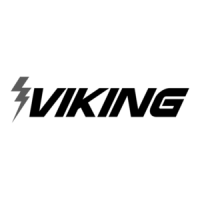How to engage Service Mode on Viking VUWC144 Refrigerator?
- SSusan PerezSep 5, 2025
To enable Service Mode, press and hold the “WARMER” button while pressing the “COLDER” button four times within five seconds.

How to engage Service Mode on Viking VUWC144 Refrigerator?
To enable Service Mode, press and hold the “WARMER” button while pressing the “COLDER” button four times within five seconds.
How to disable Service Mode on Viking VUWC144 Refrigerator?
To exit Service Mode, press and hold the “WARMER” button while pressing the “COLDER” button four times within five seconds.
Why door is closed but the light is still on inside of Viking VUWC144?
If the door is closed but the light remains on, it's likely that the “LIGHT” button was not pressed before the door was last closed. Press the “LIGHT” button to disengage the light.
How to display Celsius (C) on Viking VUWC144?
To display Celsius (C) on your Viking Refrigerator, press the “ °F/C” button to toggle between Fahrenheit and Celsius.
| Brand | Viking |
|---|---|
| Model | VUWC144 |
| Category | Refrigerator |
| Finish | Stainless Steel |
| Energy Star Certified | No |
| Installation | Built-In |
| Door | Glass |
| Weight | 150 lbs |
| Type | Wine Cellar |
| Temperature Range | 40°F - 65°F |
| Shelves | 6 |
| Width | 23.875 inches |
Guidelines and responsibilities for qualified appliance technicians performing service on Viking products.
Explanation of safety symbols (Danger, Warning, Caution) to ensure safe operation and prevent injury.
Essential safety precautions and work area preparation before attempting any service on Viking products.
Specifies electrical needs, including voltage, frequency, and proper grounding, with safety warnings.
Fundamental practices for servicing sealed refrigeration systems, emphasizing leak detection and component replacement.
Diagnosing low side leaks, high side leaks, and restricted capillary tubes within the refrigeration system.
Step-by-step instructions for re-charging the refrigeration system after repairs.
Details the functions of evaporator and display thermistors and the consequences of their failure.
Explanation of warning alarms (door ajar, temperature, power failure) and how to reset them.
Details on the compressor's role and common faults, including electrical checks.
Information on error codes generated by the system and their potential causes and troubleshooting steps.
Troubleshooting when compressor, fans, heater, or alarms are not working correctly.
Diagnosing and resolving audible alarms for door ajar and high/low temperature conditions.
Diagnosing and resolving specific error codes (E1-E4) related to component failures.
Testing methods for display and evaporator thermistors, comparing resistance values to temperature charts.
